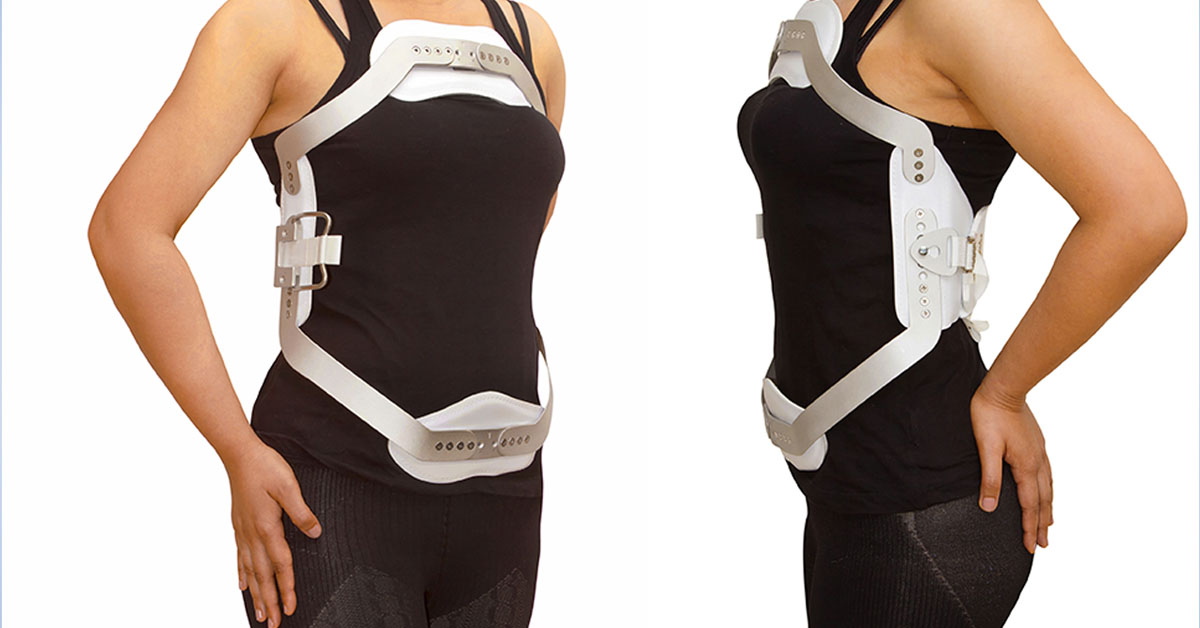
Scoliosis Bracing
Scoliosis generally develops during childhood, but it also can occur in adults. The term childhood here refers to patients who have not completed their growth (i.e., are skeletally immature). Pediatric/childhood scoliosis is distinctive from adult scoliosis in terms of the causes and treatment options.
Scoliosis is a musculoskeletal disorder that adversely affects the shape of the spine (backbone). There are normal (front-to-back) curves of the spine; however, scoliosis is a side-to-side curvature of the spine. Therefore, a scoliotic spine (when viewed from behind) will not be straight and may instead look like the letter "C" or "S", due to the side-to-side (right-to-left) curvature.
Treatment of scoliosis depends on many factors, including:
- Cause/type of scoliosis
- Location of the curve
- Shape of the curve
- Severity of the curve (i.e., the Cobb angle)
- Skeletal maturity (whether the patient's body is still growing)
One treatment option is bracing; in general, this is an option for certain pediatric patients, not adults. Depending on patient age and other factors, physical therapy may be used in addition to bracing. The goal of physical therapy is core strengthening.
What is a Brace?
A brace is a device worn to straighten the spine and hold it in that position. The goal of bracing is to prevent an abnormal curvature of the spine from progressing (getting worse). Therefore, a brace does not cure scoliosis. The brace corrects (straightens) the scoliotic curve while the patient is wearing the brace. The concept behind bracing is that certain parts of the spine (growth plates) are more likely to grow in a symmetrical manner when the pressure on them is equally distributed. There are multiple types of braces available. However, all of them are designed with the same functional goal - prevent curve progression and maintain an upright spinal column.
Conditions for Bracing
Not all scoliosis patients are candidates for bracing. For example, braces are not typically used for adult scoliosis; there are, however, exceptions. A basic guideline for bracing eligibility is if a patient has a scoliotic curve that is between 25-45 degrees and they are still growing (i.e., skeletally immature). As a rule, use of a brace is discontinued when the patient reaches skeletal maturity. These are general bracing guidelines and there are multiple reasons why a specific patient would be an exception to them.
Efficacy of Bracing
Scientific studies have demonstrated that when braces are used as prescribed (i.e., with full compliance), they are successful at preventing curve progression in approximately 80% of skeletally immature scoliosis patients. In order for a brace to be effective, it must be worn every day for the required amount of time.
Patients are given a brace schedule that explains the amount of time the brace must be worn daily and when it may be removed. The required amount of time it must be worn varies greatly. Nighttime braces are only worn while sleeping, while other braces are worn between 16-22 hours per day. A brace's effectiveness increases with adherence to the bracing schedule. Patients that do not follow their bracing schedule are more likely to have their curve progress. Typically, braces are removed for bathing and, if necessary, sports.
After a prolonged period, if the curve decreases in severity, the amount of time the brace must be worn may be reduced. It is possible after years of bracing that a curve can be controlled and no further treatment will be required. However, if a scoliotic curve progress despite bracing, surgery may be the next step.
Types of Braces
Experts disagree as to which type of brace is most effective. However, the type of brace used is determined by several factors including severity and location of the curve, and patient age. Braces can be custom-made or created from a pre-fabricated mold.
The main types available include:
Boston Brace: Also known as a TLSO brace (thoraco-lumbo-sacral orthosis). This is a plastic brace and is contoured to closely fit the body. It is worn under a patient's clothing and is nearly invisible. A Boston brace goes under the arms, wraps around the rib cage, lower back and hips. It is usually prescribed for scoliotic curves in the lower back (lumbar region) or mid-lower back (thoraco-lumbar region). This type of brace is not used for scoliotic curves in the upper back or neck. Boston/TLSO braces are the most common type of braces.
Milwaukee Brace: Also known as a CTLSO (cervico-thoraco-lumbo-sacral orthosis). This is a full-torso brace and it's more cumbersome than a TLSO brace. Therefore, Milwaukee braces are often used only when TLSO brace won't help. A CTLSO brace extends from the base of the skull down to the hips. It has two flat bars in the back, one bar in the front, and a neck ring with rests for the chin and the back of the head. This brace can be used to correct a curve anywhere in the spine.
Providence Brace and Charleston Bending Brace: These braces are nighttime only braces and, therefore, they are used while the patient is sleeping. They are designed to over-correct a sciolotic curve; that is, they cause the patient to bend in the opposite direction. Some physicians question their efficacy; they may be helpful for small, flexible scoliotic curves.




